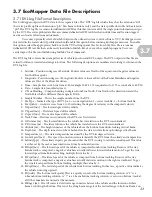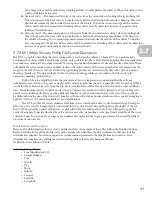
46
4.32 Instruments, Compass and Battery Charge
1. On the UVC main screen, click the ‘Instruments’ icon.
2. Verify that all instruments appear to be responding. Pay special attention to GPS, compass, and altimeter
readings to confirm that all work properly.
3. Check the ‘Power Readings’ section to confirm that the vehicle has sufficient charge for the mission.
4.33 Vacuum Pump
Before launch, check for leaks by creating a vacuum inside of the EcoMapper. The vacuum port is located on top of
the vehicle nose. If possible, perform the leak check in a controlled environment. Allow yourself sufficient time (30
minutes) to perform the test properly.
1. Remove the vacuum port plug with a 5/32" hex wrench (included in tool kit) by turning the wrench
counterclockwise.
Extended Payload (EP) vehicles have a second vacuum port in the rear of the vehicle.
2. Insert the vacuum port and finger tighten the port in place.
3. Firmly press the vacuum hose onto the port.
4. Create a pressure of 10 inHg with the pump and leave the vehicle to sit for no less than 15 minutes. The
vehicle may take up to 30 minutes to stabilize.
5. If the vehicle exhibits a leak (due to an increase in pressure), attempt to identify the problem area. The most
probable cause of a leak is due to a failed seal. If possible, try to establish a high positive pressure (no greater
than s4 psi) and listen for leaks or place the vehicle in a controlled water environment and watch for the
source of bubbles.
6. Contact YSI Technical Support if your vehicle exhibits a leak.
7. Release the pressure from the pump and replace the vacuum port plug. Be sure to check and service all
affected o-rings.
4.3
10 inHg
NOTE
10 inHg















































